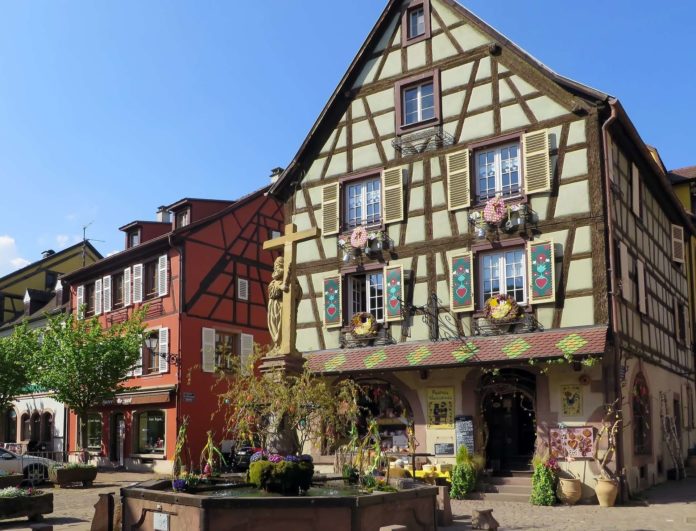The picturesque foothills of the Vosges Mountains and along the Rhine plain are a great way of discovering Alsace. The whole area is a Regional Natural Park identified by UNESCO. The uncontaminated bucolic countryside is followed by a driving path from Molsheim, past the historical towns of Obernai and Colmar, to Guebwiller, parallel to the winding Rhine River.
The journey leads to lovely small villages, quaint rural villages, and exquisitely preserved medieval cities, where vibrant flowers of potted flowers burst from pastel-painted houses and tiny paved roads invite you to take fun steps back in time.
Read our List of the Top Alsace Villages and Medieval Towns to learn what to see in this area.
1. Colmar
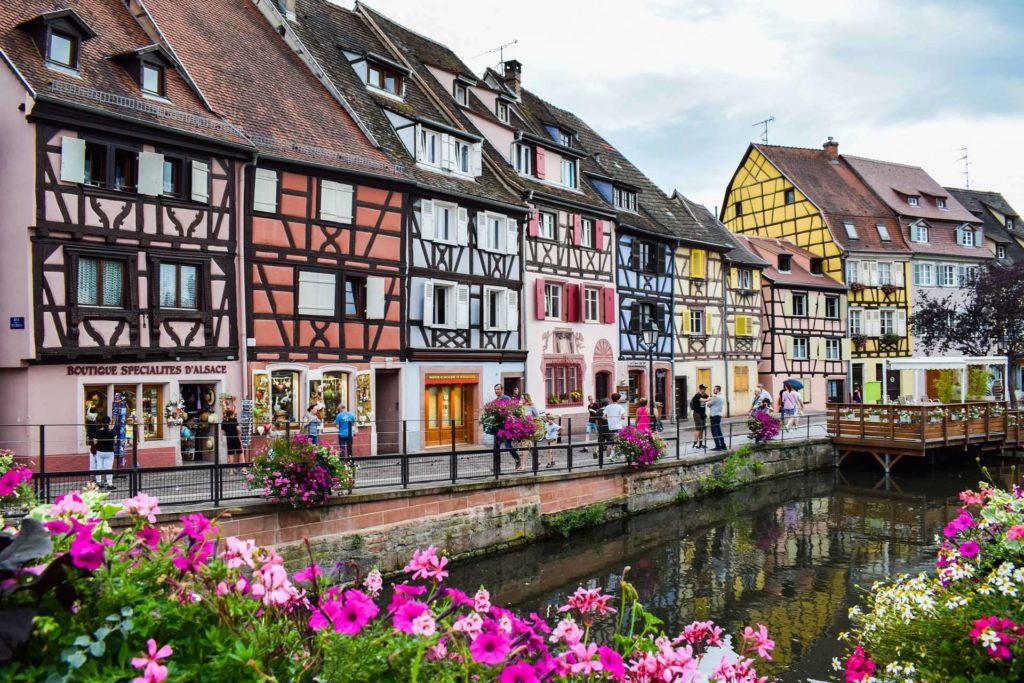
As a cultural center since the 13th century, Colmar’s fine and picturesque beauty show its significance (especially during the Protestant Reformation in the 16th century). Colmar has preserved the charm of an earlier period with its historical neighborhoods, winding pedestrian streets, and atmospheric canals. The town’s wooden burgher houses are traditional for the area, with balconies decorated in spring and summer, with potted geraniums. Because of its dynamic floral shows, Colmar has earned the distinction of “Ville Fleurie”
The vibrant city of Alsace is full of old world air, especially in the Krutenau district. This neighborhood is also known as “Little Venice,” and visitors will embark on a boat tour through the canals. Tourists will visit the magnificent architecture, including the Maison des Têtes, the magnificent Renaissance palace, and the Maison Pfister, one of the city’s finest old houses from the 16th century through the historic center of the town. The Musée Unterlinden represents a must to appreciate beautiful art, whereby the Koïfhus (Old Customs House) provides a glimpse of Colmar’s successful commercial activities in the Medieval Period.
2. Riquewihr

Riquewihr is one of the “Plus Beaux Villages de France” situated between the crests of the Vosges Mountains and the vast Alsace plain (Most Beautiful Villages of France). From a point, Riquewihr looks like a painting in a children’s storybook with the church steeple rising above the village. The best place to view the village is from the path near the Tour des Voleurs (Thieves ‘Tower) of the 14th century.
Riquewihr has been given the title of “Village Fleuri” (Flowering Village), and has several historic buildings adorned with flowering balconies. The village has nice public squares decorated with fountains, in addition to the charm. The village’s main street, Rue du Général-de-Gaulle, is a lovely spot for a leisurely stroll. The rue du Général-de-Gaulle ends at the Tower of the Dolder Gate, built in 1291 and now a museum. There are plenty of cafés, bakeries, boutiques, and restaurants for such a small village that cater to the many tourists who visit throughout the year.
3. Obernai
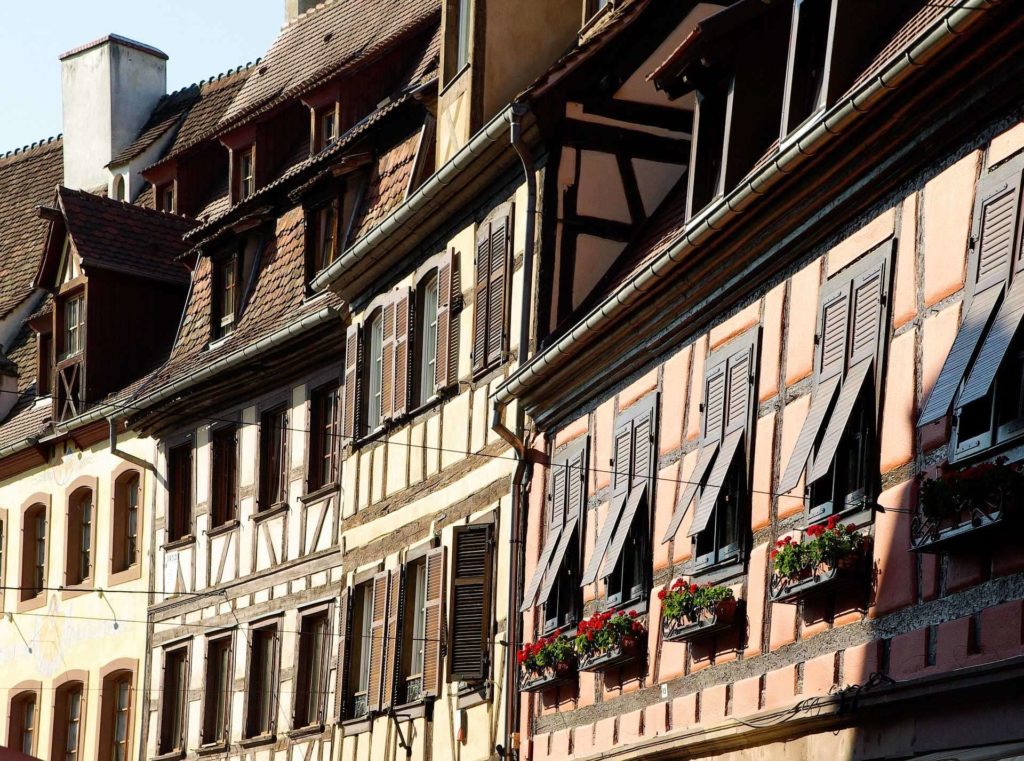
This Free Imperial City of the Holy Roman Empire has maintained its medieval atmosphere about 25 kilometers south of Strasbourg, as seen in the tower of the 13th century, old town gates, narrow pedestrian streets, and typical houses of the bourgeoisie. Featuring Gothic and Renaissance buildings, the Place du Marché (Market Square) offers an elegant air.
A quick walk from the Place du Marché, with its ornate Alsatian-style balcony, the 15th- to 16th-century Hôtel de Ville (Town Hall) dazzles viewers. The Puit des Six Seaux is one of Obernai’s most scenic locations, situated nearby the Hôtel de la Cloche (Six-Bucket Well). A few more blocks away, visitors will stroll to Place de l’Etoile, a charming square with angular half-timbered houses and nests of storks on the roofs.
5. Ribeauvillé
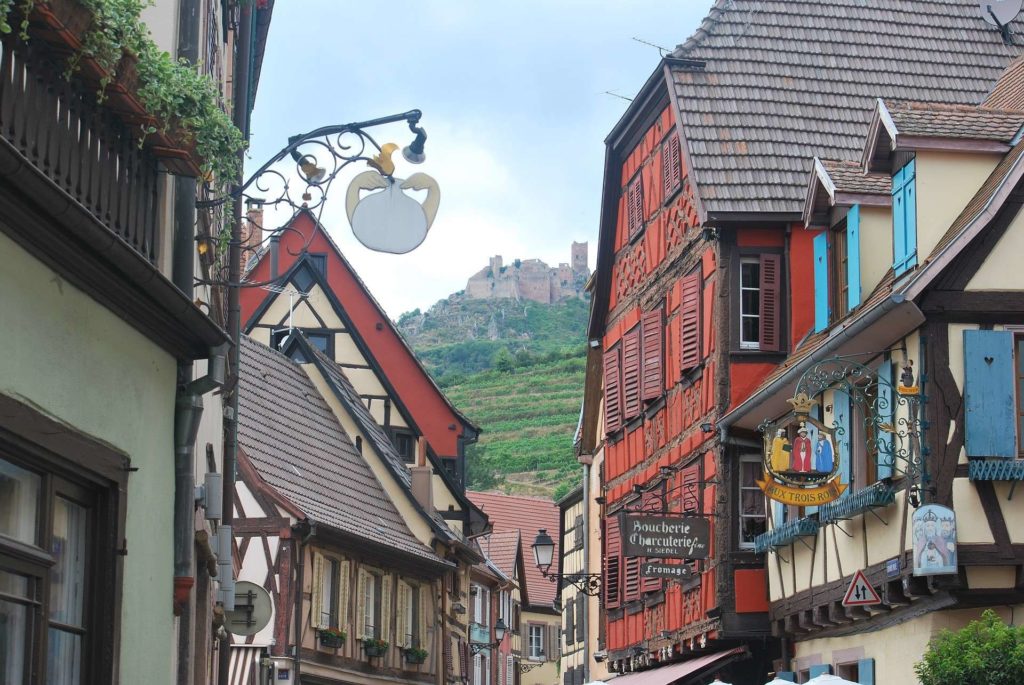
This pretty little village practically blossoms with quaintness (only four kilometers from Riquewihr). Potted flowers adorn the window sills of historic houses during spring and summer, as well as public spaces, such as fountains and sculptures. Ribeauvillé has been awarded the status of four-star Village Fleuri – the highest-ranking, thanks to these outstanding floral displays. In its atmospheric cobblestone streets and small squares, the village’s magic is further unveiled.
Tourists can arrive for the Fiddlers’ Festival in September or the Medieval Christmas Market in December to explore Ribeauvillé’s medieval heritage. Ribeauvillé was ruled during the Middle Ages by the Count of Ribeaupierre, regarded as the “King” of the traveling musicians of the area, who paid dues to him for his defense and gathered annually for “Pfifferdaj” (the Fiddlers’ Festival, still celebrated every year on the first Sunday in September) at Ribeauvillé. The Kougelhopf Festival in May (a special cake made with motifs and almonds) and the Festival of Ancient Music in October are other cultural activities.
6. Eguisheim
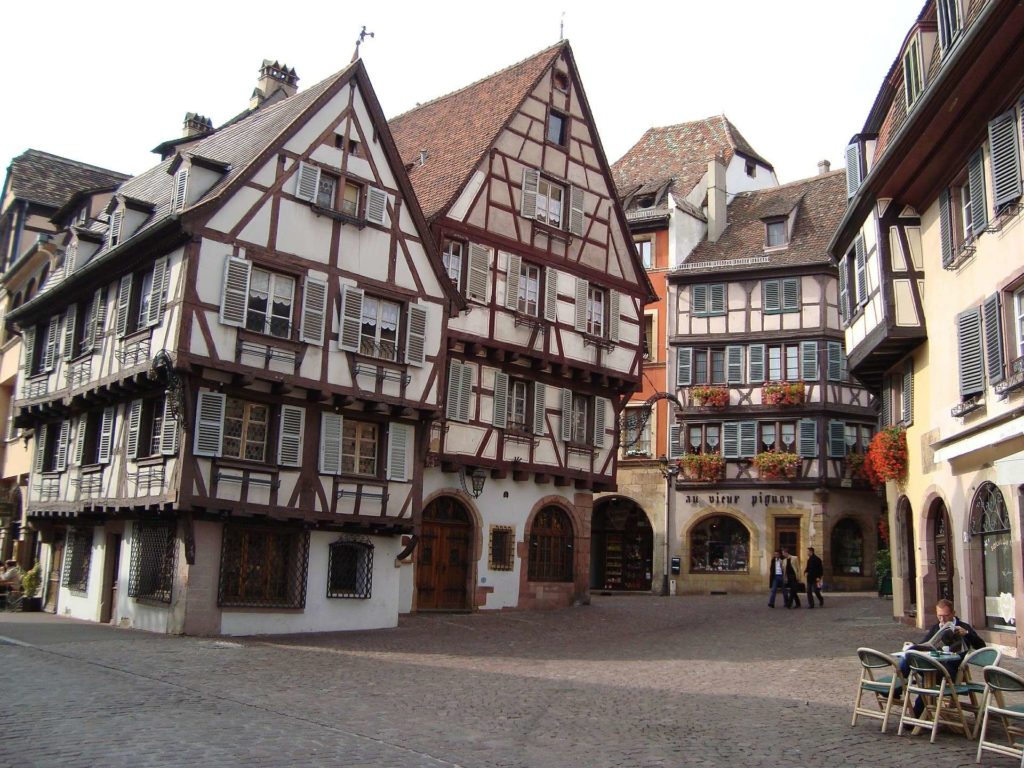
Nestled in a sunny valley surrounded by the vine-covered foothills of the Vosges Mountains, the traditional Alsatian town of Eguisheim (five kilometers from Colmar) is situated. The village has won many distinctions because of its beauty and charm: it is one of the “Plus Beaux Villages,” of France, as well as a recipient of the “Grand Prix National du Fleurissement,” the most coveted national floral award in France, and in 2013 it was voted the “village préféré des Français” (favorite village in France). After exploring the enchanting cobblestone streets of the area, visitors can understand all the praise.
In a concentric pattern, the narrow lanes wind around the village, offering the impression of being in a fairy-tale setting. Half-timbered, brightly painted houses from the 16th and 17th centuries feature window sills that are lovingly decorated with potted flowers. The captivating ambience of Eguisheim makes it one of the top Christmas destinations in Alsace. The village celebrates the season in the Alsatian tradition with a festive Marché de Noël (Christmas Market).
7. Sélestat
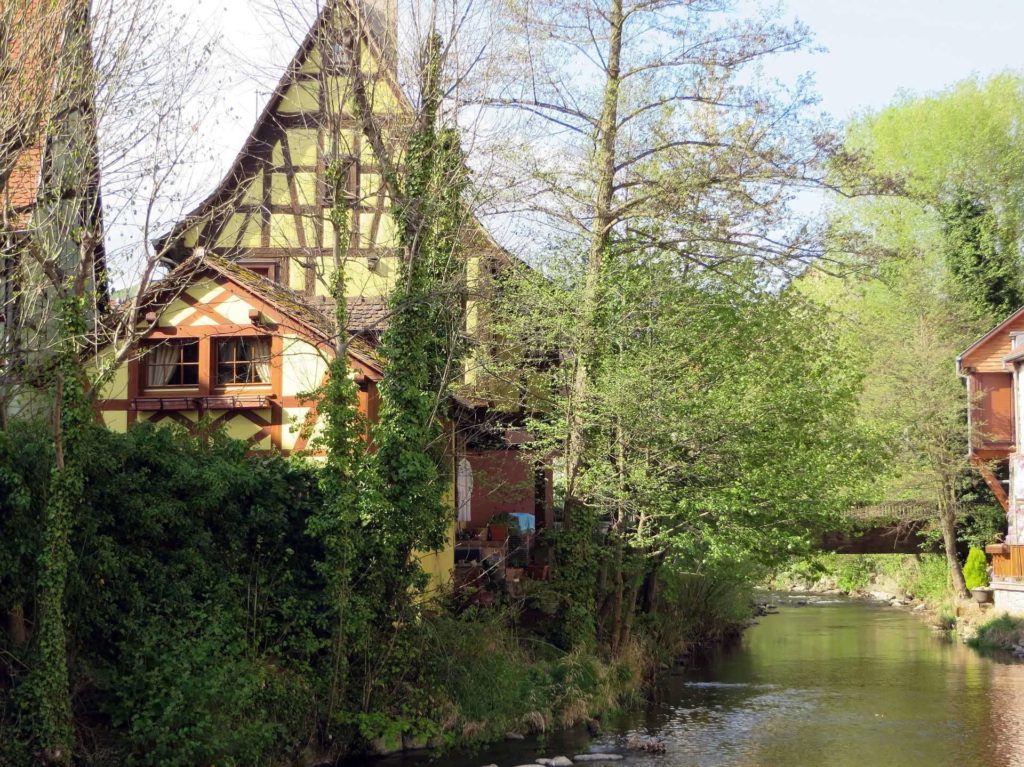
The cultural heritage of Sélestat is rich, starting with the Capitol of Carolingia in the 8th century and then the Holy Roman Empire Free Imperial. “Ville d’Art and d’Histoire”Ville d’Art and d’Histoire (City of Art and History). Established in 1452, Sélestat has a library with thousands of valuable manuscripts dating from the 7th to the 16th centuries.
The Hôtel de Ville (City Hall) is at the center of the town, and two outstanding churches are nearby: the three-towered Romanesque Eglise Sainte-Foy and the 13th-century Eglise Saint-Georges, featuring Max Ingrand’s new stained-glass windows. Visiting the Maison du Pain d’Alsace, a museum and working bakery dedicated to the art and techniques of Alsatian baking, is one of the enjoyable things to do in Sélestat. Visitors will watch the bakers make local specialties such as pretzels, kougelhopf, brioche, bredele (cookies), and a large range of bread (and then try some at the coffeeshop).
8. Münster
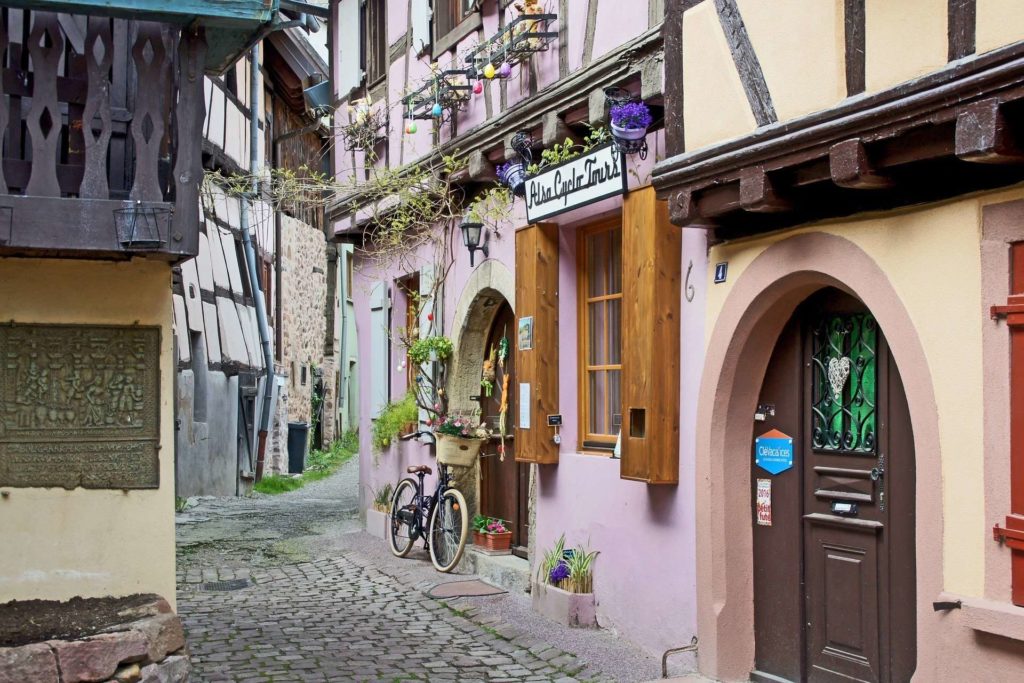
Münster, popular for its cheese, is a good starting point for exploring the “Route du Fromage” (Cheese Trail). This gourmet experience can be started by tourists sampling cheeses at the Maison du Fromage (a cheese museum) and at farmhouse inns. Another local culinary specialty is called “tourte,” a “vol-au-vent.” style of beef.
The Münster Valley is an excellent base for those visiting the Alsace region for excursions to villages across the Vosges mountains such as Equisheim (20 kilometers away), Hattstatt (25 kilometers away) and Rouffachach (30 kilometers away). The cities of Turckheim and Colmar are both 30 minutes apart by car.
9. Dambach-la-Ville
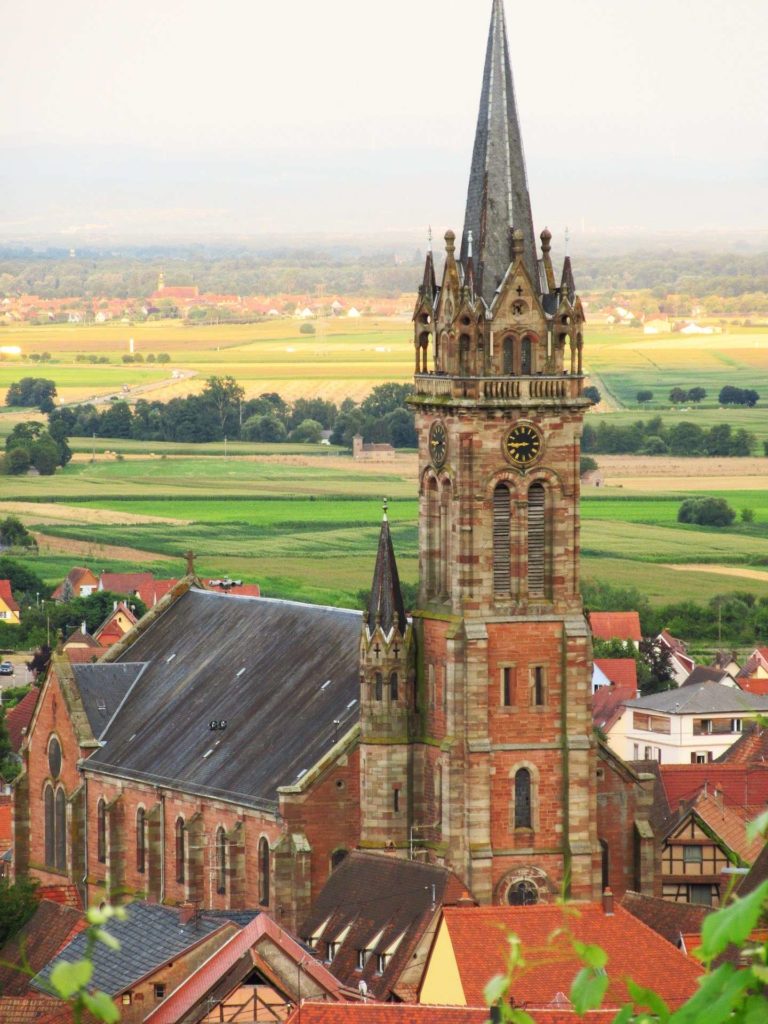
This medieval walled town will amaze you. A beautiful landscape of vine-covered rolling hills surrounds it. For the town’s brightly painted half-timbered houses, the beautiful natural backdrop is the perfect juxtaposition. While wandering through a maze of winding cobblestone streets, visitors will enjoy discovering the beauty of Dambach-la-Ville. Travelers need only venture just outside Dambach-la-Ville, where there are many hiking trails through the countryside, to continue the scenic strolls. Other excursions include the nearby village of Epfig, which has a rare 11th-century Romanesque chapel (eight kilometers away).
Dambach-la-Villeone is one of the best places to visit in order to savor Alsatian culture – especially during the Fête de la Myrtille (Blueberry Festival), which takes place in July every two years. This lively festival draws crowds that come to taste the fresh blueberries, handmade blueberry pies, tarts, and juices.
Every year in early December, another festive occasion is the Marché de Noël, which brings the Christmas spirit to the city with live music concerts and an old-fashioned craft market. Vendors sell unique Christmas decorations and gift items at dozens of stalls set up outside the Place du Marché and inside the Town Hall and the Salle de la Laube.
10. Rosheim
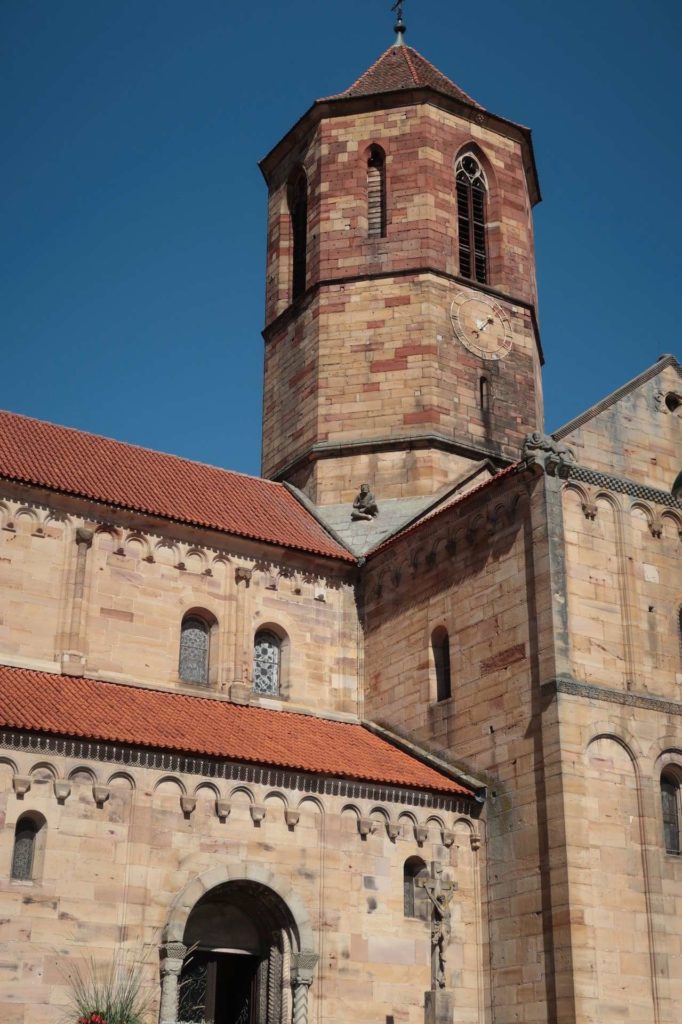
In the vestiges of its past, Rosheim has an interesting heritage: medieval walls with gated towers, one of the finest Romanesque churches in Alsace (Saint-Pierre-et-Saint-Paul Church of the 12th century), and many half-timbered, flower-covered houses. “(A “Ville Fleurie” is listed as Rosheim). Only six kilometers from Obernai, this historic town was another Holy Roman Empire Free Imperial City. The town has evidence of a Jewish community dating back to 1215, which is equally intriguing. Even though the Jewish synagogue of the 19th century is now closed, tourists can still appreciate its neo-Romanesque façade.
11. Molsheim
The medieval town of Molsheim is surrounded by a labyrinth of cobbled roads with beautifully preserved old houses. Tourists should begin at the old marketplace of Place du Marché, and then walk a few blocks to Place de l’Hôtel de Ville to see the “La Metzig” (Butchers’ Guild House) of the 16th century. The ground floor of La Metzig is now a restaurant serving genuine Alsatian cuisine. The Church of the Jesuits was built in 1617 on the outskirts of the city. One of the finest examples of Jesuit architecture in Alsace is this monumental church.
12. Turckheim
Turckheim is a place of history in the green Münster Valley, only six kilometers from Colmar. The medieval gates, relics of the old mall of the city: the 14th-century Porte de France, the Porte de Munster, and the Port du Brand are all visited throughout the city.
The history of the town is told by other well-preserved monuments. Sainte-Anne Romanesque Church dates back to the 12th century. The Corps de Garde was a building in the town guilds of the 16th century, while the 17th century Hôtel de Ville (town hall), when Turckheim was an imperial town, was the Court of Justice (from the 14th to 17th centuries).
The Turckheim events include an Easter ceremony and the Trois-Epis Car Race throughout the year. The village is well known to celebrate its Christmas celebrations (1st to 24th December) including a candlelight Advent calendar ritual, Christmas sweets, and “Wiehnachts Bredele” (Christmas cakes). A highlight of Christmas in Turkheim is the Noel Market des Lutins, a Christmas village of small homes created by local craftsmen and artisans. Gifts and delicacies like cupcakes are distributed every night.
13. Andlau
Andlau is a picturesque town located in a quiet valley, next to the forests of the foothills of the Vosges, where once roamed bears. The bear is a town’s symbol and is also Christian in Andlau. The local legend has that a bear was designated to build Andlau’s Abbey in Saint Richard in the ninth century. This is why bears appear at Saints-Pierre-et-Abbatial Paul’s Church. The crypt of the church is guarded by a stone sliced bear, and in the complicated reliefs on the outside, there is a small bear. Other sculptures from the whimsical bear decorate the city.
14. Mittelbergheim
Mittelbergheim is one of the ‘Plus Beaux Villages de France’ at the foot of Mount Saint Odile in a ravishing landscape of vine-covered fields. This charming village (three kilometers from Andlau) has a remarkable unity of architectural style, with most buildings dating from the 17th and 18th centuries.
Mittelbergheim is also famous for its cuisine. Many traditional restaurants in the village offer regional specialties, made from local markets’ fresh ingredients.
This countryside is ideal for walking around Mittelbergheim. Various trails outside the town offer magnificent views of the idyllic landscape. Mittenbergheim is a good place to relax, enjoy nature and experience the joy of life in Alsace with its slow-paced country feeling.
15. Bergheim
This walled medieval village is one of the few Alsatian villages in the Vosges mountains with its medieval fortifications (built in 1311), still intact. The tourist is happy to walk the winding roads of the village; to walk along the walls; and to visit the medieval Jardin d’Aneth, where beers and medicinal plants are cultivated.
The Place du Marché, where the Village Coat of Arms is built, the Grand Rue, with its beautiful flowers, the Eglise Notre-Dame de l’Assomption, and the Fountain, is also part and parcel of your tour (parish church).
16. Hunawihr
The beauty and romantic nature of Hunawihr have won it a position on the “Les Plus Beaux Villages de France.” list. This charming country hamlet is surrounded by vine covered hills and woods and has tranquil streets bordered by floral-dressing wooden houses.
Apart from its pastoral charm, Hunawihr is also famous for its fortified church (15 to 16th centuries churches of Saint-Jacques le Mjeur), where villagers were sheltered in invasive times; the Butterfly Garden where exotic butterflies thrive in greenhouses reproducing natural habitats.
17. Neuf-Brisach
Set in the Alsace Plain on the Green Path, this special fortified citadel leads to the Black Forest in Germany. Neuf-Brisach is listed as a UNESCO World Heritage site due to its outstanding historical and cultural importance. Founded in 1699 for King Louis XIV (the Sun King) as a citadel, Neuf-Brisach features architecture never seen before in Europe and is considered to be Vauban’s masterpiece. The pure lines of the citadel and 48 quarters form a complete octagon, an astonishing architectural achievement.
18. Mont Sainte-Odile
The Mont Saint-Odile, one of the spiritual highlights of a tour in the Vosges, is an emblematic Alsace Catholic monument. This pilgrimage site attracts both religious pilgrims who come to pray and visitors who come to simply experience the environment’s beauty and serenity. Mont Sainte-Odile, situated on a wooded ridge 753 meters above the surrounding countryside, offers a peaceful natural environment and awe-inspiring views. Mont Sainte-Odile is also a tourist destination with a hotel, restaurant, and self-service cafeteria, in addition to being a working monastery.
Ten kilometers of a prehistoric defensive wall known as the Mur Païen (Wall of Heathens) surrounds the Mont Sainte-Odile convent. The two-meter-thick wall stands about six meters high in height. The site of the original convent of Sainte-Odile, which was destroyed in a fire in 1546, stands on the top of a hill (511 meters) outside the modern convent.
19. Château du Haut-Koenigsbourg
An important symbol of the Alsatian heritage is this breathtaking castle (15 kilometers from Ribeauvillé and 10 kilometers from Bergheim). The majestic Château du Haut-Koenigsbourg is situated at an impressive height, like many medieval fortresses. The fortress was strategically situated on a rocky promontory more than 700 meters high, to observe the landscape and provide defense in the case of invaders. This amazing monument has witnessed the course of European history since the castle was built by the Hohenstaufens in the 12th century.
The Château du Haut-Koenigsbourg was restored to its original splendor from 1900 until 1908. A joy to explore is the spectacular renovated castle. Visitors circle through the spiral stairways that lead to the living quarters that are fully furnished.
The drawbridges, armory, and cannons, which recall the military purpose of the fortress, are other noteworthy aspects. Visitors can take in exhilarating panoramas that encompass the plains of Alsace, the Vosges Mountains, and the Black Forest from the Grand Bastion artillery platform. The castle also has a medieval garden used during the Middle Ages, planted with flowers, plants, and medicinal herbs.
20.Neuf-Brisach
Neuf-Brisach (nickname from the original Neuf, meaning “mountain near the woods”) is a town and commune of the region of Haut-Rhin, in the French region of Alsace. The town became a major center for the mining industry in France, famous for its abundant deposits of zinc and lead. The town became fortified in medieval times, and the Chateau de Neuf was built here in 1013 during the time of King Henry II. The fortified city was designed to protect the porous border with the Holy Roman Empire and then, later, to protect the frontier with Germany. Today, this is still the main commercial center in the region.
Many people from across the world visit the region of France, taking advantage of some of the best ski resorts that France has to offer. Skiing is popular in France, especially in Alsace and at Courmayeur, also in the south-western part of the country. Winter sports like ice hockey are also popular attractions for international visitors.





